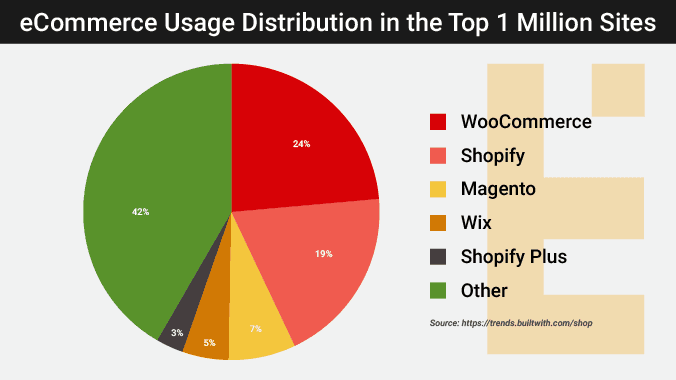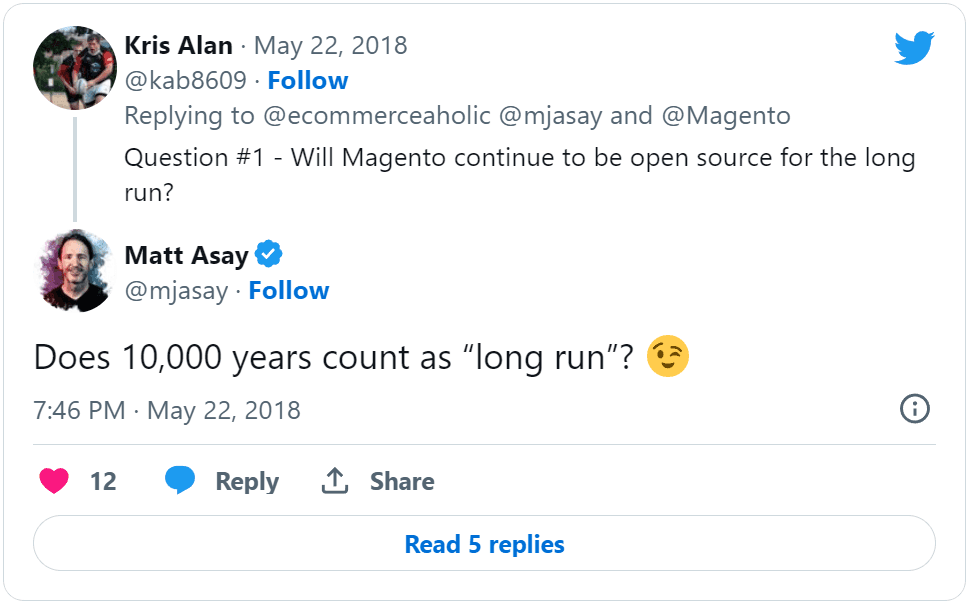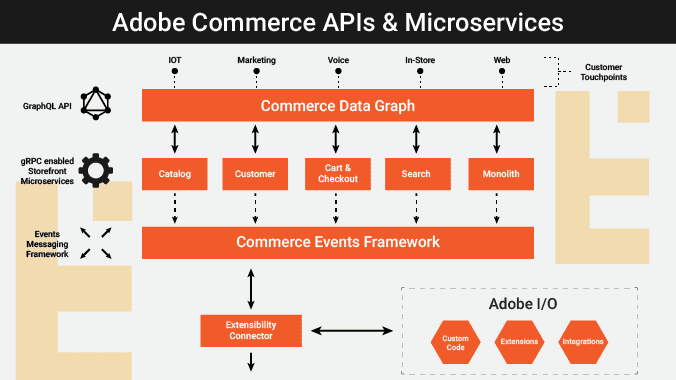The Future of Magento 2 & What It Means for Magento Store Owners

Magento took the ecommerce industry by storm in 2008. Even search data from Google Trends reveals that the search term “magento” was more popular than “ecommerce” from April 2009 to October 2017.
Fast forward to the present, and Magento’s popularity has declined. Moreover, Adobe’s rebrand of Magento Commerce has left many wondering if Magento has a future and, if it does, what the future looks like.
If you’re here for the short answer, here’s our take: Magento will remain one of the top ecommerce platforms for businesses worldwide. Its flexible architecture will empower Magento users to adopt emerging technologies like AI-powered retail and headless commerce.
The long answer? Keep reading to find out.
Understanding Magento’s Past
Magento started as a side project in early 2007 when developers Roy Rubin and Yoav Kutner identified the need for a flexible and scalable ecommerce platform.
They used components from the Zend Framework, the only suitable option for enterprise applications at the time, to develop Magento 1 as a monolithic application.
Bundling the front-end and back-end of Magento made it easy to install and deploy. Plus, its extensible codebase enabled merchants and developers to extend all parts of the application.
Magento’s ease of use and extensibility made it revolutionary for its time. That’s why, within a year of launching, Magento became the top open-source ecommerce platform globally.
However, despite its success, Magento 1 wasn’t entirely future-proof. Users started experiencing store performance issues when new features were introduced into the platform.
That led to the development of Magento 2, which introduced several improvements such as:
Varnish caching.
Support for newer technologies.
Streamlined catalog, inventory, and order management.
Built-in security features like Two-factor Authentication.
Magento has continued evolving as an ecommerce platform over the years. For instance, the present owner of Magento 2, Adobe, introduced the official Page Builder tool in the community release of Magento 2.4.3 to simplify content management.
However, even as Adobe continues introducing dozens of security and functionality improvements with every new release, Magento’s popularity is declining.
Taking Stock of Magento’s Present
One of the primary reasons behind the decline in Magento’s user base is the success of low-code/no-code platforms like Shopify and WordPress.
Where Magento 2 forces users to the command line to install extensions and update the application, low-code platforms let users perform those tasks from a browser without needing technical skills.
So it’s no surprise that data collected by BuiltWith shows low-code technologies dominating the ecommerce technology usage charts.

However, even though Magento’s user base has declined, major ecommerce brands like Coca-Cola, Tommy Hilfiger, and ASUS still use it. That’s because no ecommerce platform offers the same extensibility, scalability, and control as Magento 2.
But a declining user base isn’t the only reason the community questions Magento’s future.
The first doubts about Magento’s future surfaced when Adobe acquired Magento in 2018. Many in the community were concerned about the future of Magento 2.
However, Adobe’s Head of Developer Ecosystem, Matt Asay, addressed their concerns on Twitter saying:

Matt’s comment put everyone’s concerns to rest. But those doubts resurfaced when Adobe rebranded Magento Commerce and shared its plans to replace Magento’s monolithic architecture with microservices.
Microservices are separate software components that work together. Unlike monolithic applications (like Magento) that package modules such as catalog, inventory, and payments together, microservices use individual services for each business function.
Adobe’s decision to integrate Magento into its ecosystem without a public roadmap for Magento Open Source (Magento’s free version) led many to question the future of Magento and its long-term viability. At the same time, it has fueled new initiatives for the future of Magento 2.
The Future of Magento Open Source & Adobe Commerce
As Adobe focuses on migrating Magento Commerce to a microservices architecture, the Magento Association is now taking over the maintenance and development of Magento Open Source.
Moreover, some in the community have established a different organization called the Mage-OS Association to ensure the long-term success of the Magento platform and ecosystem.
Let’s explore how each organization is working towards building a prosperous future for Magento.
Adobe’s Push for Microservices
Adobe views Magento’s existing architecture as a hurdle towards future-proofing the platform. That’s why, Adobe’s currently developing a new microservices-based framework for Magento that will replace the existing PHP-based Magento Framework.
The new framework will allow you to create customizations using serverless functions on Adobe I/O by using:
Progressive Web Apps for the front end.
Adobe I/O for the backend business logic.
GraphQL and REST APIs and middleware to connect the front- and back-ends.

Adobe’s new approach will reduce conflicts in the core code. You’ll get SaaS-like effortless upgradability without extensibility issues or code conflicts.
Magento Association’s Initiative
The Magento Association has been organizing meetups and nurturing the Magento community for over a decade. But now that Adobe has shifted its focus to Adobe Commerce, the Magento Association will play a major role in the future of Magento Open Source.
The Magento Association introduced the Magento Open Source Task Force in October 2021 to investigate, recommend, and plan the future of Magento Open Source. This task force now works with Adobe to maintain and improve Magento Open Source.
Mage-OS Association’s Vision for Magento Open Source
As Adobe works toward decomposing Magento, the Mage-OS association is working to preserve the monolithic architecture that helped Magento succeed. Their vision for Magento Open Source is simple: to rally the community and ensure a bright future for Magento Open Source.
Mage-OS has created a copy of the monolithic Magento code base and plans to maintain it with the community’s assistance. That way, when Adobe shifts to a microservices-based architecture, merchants using the monolith will be able to keep using it.
Mage-OS’s vision for Magento Open Source is to develop an ecosystem where merchants, agencies, and technology partners can thrive. Mage-OS’s distribution of Magento will offer a lightweight package that’s cheaper to host and less complex.
Magento 2 Future: Putting It All Together
The Magento community is buzzing with activity as Adobe works towards its vision for a headless Magento. Whether you’re new to Magento 2 or have been using it for years, you can be sure of one thing: Magento is here to stay.
Magento has fueled innovation in the ecommerce industry since 2008 and it will continue to thrive under the guidance of Adobe, the Magento Association, and the Mage-OS Association.
If you want to migrate your online store to Magento 2 for more ecommerce control over your store or need help preparing for the future of Magento, contact us for a free consultation today.
